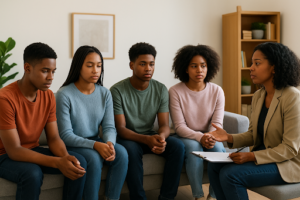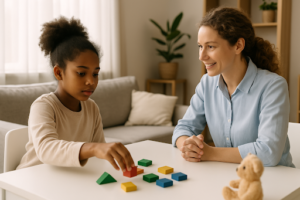Parents and other adults who care for children who are going through puberty often feel a range of feelings. They may be proud of their child’s growth, worried about what the future holds, and eager for the change to go as smoothly as possible.
When a child has autism, these thoughts are even more complicated for the parents. Teenage years aren’t just about changes in the body; they’re also a time when independence, mental growth, and social awareness become more important in daily life.
During this time, our kids may grow with focused and careful ABA-based puberty support. What we do for them may pay off in a big way. We could make a time that could be challenging into a time of growth, which boosts their confidence, self-awareness, and life skills that will stay with them.
Why Long-Term Skill Building Matters During Puberty
Teenage years are not a phase; they are a change on a child’s way to becoming an adult. What is talked about goes beyond the physical changes that everyone goes through for autistic people.
Problems with your senses may get worse, your feelings may get stronger and harder to handle, and your social interactions may become more complicated. For this reason, we see ABA as not just a short-term fix for puberty. We are building a foundation that will help your child for years to come.
When we work on our skills over a long period of time, we see steady and slow growth. We offer ABA life skills training that focuses on real-life skills like self-care, organization, and personal cleanliness. We work on these skills over time so that the child can use them in their daily lives. This steady, slow growth keeps the child from getting too stressed out and lets them learn at their own pace.
Also, it’s not just taking care of yourself. We think that ABA plays a big role in developing social skills because it helps kids understand personal limits, make healthy friends, and understand social cues better. As we get older, friend relationships and social identity start to form, which affects our confidence and ability to do things on our own.
Center-Based ABA: A Supportive Roadmap for Puberty and Beyond
In a center-based ABA setting, kids can practice new skills with skilled professionals in a safe and structured setting. They can then take these skills home, to school, and into the community. We can also see that behavior intervention centers act out real-life events in a safe and helpful environment. This makes it easy for kids to learn and grow.
1. Gaining more confidence in how to clean and care for your body
In most ABA programs for teens, the hygiene practice is broken down into easy steps. Therapists may break down a job, like taking a shower or brushing teeth, into small steps that the child can handle in order to help them succeed. There is a lot of work that goes into making sure that these habits are automatic in life skills training and daily living skills ABA treatment.
Changes that are easy on the senses are also thought about to improve comfort and compliance, you can change the water temperature, pick goods without scents, or choose softer fabrics.
2. Health and hygiene during your period
ABA has a program to help people who are going through puberty, and as part of it, they slowly and politely introduce ideas about menstrual care. In this, you might learn how to use pads or period underwear, how to properly dispose of them, and how to put together a small “period kit” for school or other trips.
Visuals and role play can help kids who are having trouble with time, comfort, and pain. We also use transition planning ABA to make sure they are ready for the first cycle.

3. Right to privacy, privacy, and limits
A lot of kids don’t understand what privacy means. To teach these ideas in a kind and non-threatening way at a behavior intervention center, we use role play, visual tools, and real-life examples.
In ABA for social skills development, kids learn to knock before they come in, know which areas are public and which are private, keep their private things to themselves, and respect the space of others. To help them say “no” and understand what it means when someone else says it, ABA also uses routines and role play. This is very important for safety and respect.
4. Dealing with emotions and talking to people
As a teenager grows up, their feelings may seem much stronger. As for tactics, we’ve found that teaching our kids to name their feelings, use tools to calm down, and ask for a break works well.
Most of the time, we see that visual tools, mood charts, or sensory spaces for kids are what are being talked about. We can also see that they are given help with communicating, which could be through spoken language or AAC. This lets them get their needs across.
5. Getting through friendships and social changes
Relationships with friends can make puberty more difficult. ABA helps kids improve their social skills by teaching them how to read facial expressions, take part in group discussions, and handle problems with their peers.
In the center, they work on projects and play games with others in small groups, where they can use their skills right then and there. Therapists are also there to help them work through problems. In the long run, this also gets them ready for youth programs and activities in the neighborhood.
6. Safety online and making smart use of media
The more independent we become, the more online we become. ABA programs for teens can teach teens how to stay safe online by teaching them things like how to share personal information wisely, what kinds of pictures to post, and how to handle annoying messages.
Therapists use decision trees, role play, and guided practice to help kids feel more confident and aware of what they can and can’t do online.
7. Being able to make decisions and be independent
Getting daily freedom takes time and work. ABA for independent living skills helps kids learn how to set up their own space, stick to routines, keep track of time, and make simple meals. In daily living skills of ABA, these skills are practiced at home and at the center. This makes the skills a normal part of the child’s life everywhere.
8. Actively promoting your own health
When ABA works with teens and young adults, body awareness is taught in a way that is appropriate for their age and shows respect. We tell therapists to act out doctor visits with kids to help them learn how to ask questions. We also work to make kids feel more comfortable talking about health problems.
9. Taking part in the community
The goal of ABA is to help young people get ready for life as an adult, which includes getting ready for work and the community. This could be anything from volunteering or taking the bus for the first time to getting ready for a job, which could include things like clocking in and out, keeping on task, and asking for help.
10. Family counseling to make changes that last
Therapists and families work together to help kids learn ABA skills in a way that lasts. We think that the child’s growth outside of the center is most important and that they get regular updates, home practice plans, and coordinated strategies.
Parents are told what to do and how to help their child get through this change by being patient, encouraging, and respectful.

Willow Reach ABA: Your Growth Guide
At Willow Reach ABA, you can get ABA treatment and help with behavior problems from them in Maryland and Texas. We give parents the tools they need to feel confident and supported.
- Options for at-home ABA services and center-based ABA care: Willow Reach ABA fits right in with what your child and their family need. We come to you, whether it’s at home, where you’re relaxed and know what to expect, or in a structured behavioral intervention center.
- Parents get training to help their kids learn so that they can be active participants in their own lives. At Willow Reach ABA, we give caregivers tools that are used in all parts of ABA training for daily living skills.
- Allowing each child to reach their full potential: We at Willow Reach ABA have one main goal: to help each person grow, learn, and succeed in ways that are important to them and their families. We use ABA therapy that has been shown to work along with a very personalized and caring approach. We show that progress is normal and possible in this setting.
Something To Remember
Every milestone, big or small, is a victory worth celebrating. With the right guidance, support, and strategies, children can develop the skills they need to navigate the world with confidence.
If you’re ready to take the next step in your child’s growth journey, Willow Reach ABA is here to guide you every step of the way.
Frequently Asked Questions About Puberty Readiness with ABA Therapy (FAQs)
- Will my child be able to manage hygiene independently during puberty?
With ABA classes, kids can learn detailed routines for things like taking a shower, putting on deodorant, and taking care of their periods. These are learned through practice, prompts, and visual check lists. Over time, they become skills that you can do on your own.
- How can parents support puberty readiness at home alongside ABA therapy?
Sticking to a routine, using the same teaching tools at home, and making sure there is a safe place for questions can help parents support what their kids learn in lessons.
- If my child is nonverbal, how can they be prepared for puberty?
ABA therapy experts use different ways of communicating, like PECS, AAC devices, and visual schedules, to get information about things like body changes, feelings, and hygiene in a way that works for them.
- Is it possible to include peers or siblings in puberty readiness training?
It is true that involving siblings or trusted peers in the process improves social understanding and empathy and gives practice in how to behave in social situations. This all happens in a structured learning environment that is also very safe and is supervised by an ABA therapist.
Let’s continue the conversation! Follow Willow Reach ABA on Instagram and Facebook to get the latest ABA tips, insights, and support.
